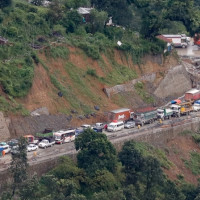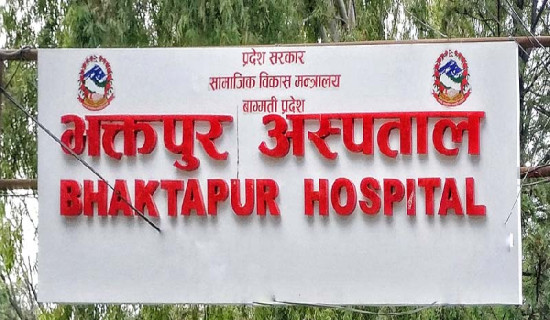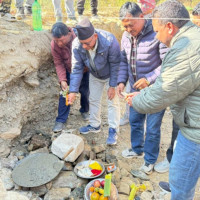- Friday, 20 December 2024
Recharging ponds on hilltop for spring water
By Kabiraj Ghimire,Hile, Nov. 16: Small pits can be seen scattered across the hill in Hile, of Dhankuta Municipality - 1, between Sri Number Brigade Number 2 and Horizon Hotel. There are over a thousand such pits in the area. Anyone who visits the hill might wonder who created these pits and why.
These pits have been created by the consumers of the Boje Spring Consumer Committee with the help of Dhankuta Municipality and various water-related organisations.
These pits were made to recharge the water sources when the main water springs begin to dry up. The idea is to collect rainwater and other water that falls during the rainy season, allowing the water to seep into the ground. This helps replenish the drying springs and locals hope it will address the issue of water scarcity.
According to Kedar Kumar Sinjali Magar, Chairman of the Boje Spring Consumer Committee, over 1,000 recharge ponds have been constructed in this area alone. During the rainy season, around 2 million litres of water that would have otherwise flowed away is captured and absorbed by the ground. “The absorbed water then flows out through the springs in the lower areas, which helps reduce water scarcity during the dry season,” Sinjali said.
According to Ongda Tamang, Ward Chairman of Dhankuta Municipality Ward No. 1, these pits were dug to ensure that rainwater does not flow away but instead seeps into the ground. This process will help restore the drying springs and eliminate the lack of water. Currently, there is an ongoing campaign in the Hile area to revive old ponds and dig new recharge ponds. This region is also a major source of drinking water for the Dhankuta market.
“This is an important step to reduce the problem of drying springs, and we have launched this campaign with the local community and various organisations working in the water sector,” Tamang said.
With the collaboration of Dhankuta Municipality, the International Centre for Integrated Mountain Development (ICIMOD) began this campaign in 2018. Based on studies conducted from 2017 to 2019, ICIMOD developed the Nibuwa-Tankhua Watershed Management Plan, covering Ward No. 1 to 8 of Dhankuta and Ward No. 2 and 3 of Chhathar Jorpati Rural Municipality, said Bikash Adhikari, who is the focal person for the watershed plan in Dhankuta Municipality.
During the process, discussions and workshops were conducted with the participation of the community, ward committees, municipal and rural municipalities, forest user groups, water user committees, the Department of Forests and Soil Conservation and local NGOs. These discussions resulted in plans to protect old ponds and water sources and to create new recharge ponds and pits. ICIMOD also arranged a visit to Sikkim for local representatives and stakeholders to observe successful water recharge practices, Adhikari said.
The watershed conservation work has been ongoing for four years in the urban areas. During this time, the community has been made aware of the water recharge system, which helps with livelihoods and involves the community in creating recharge ponds and pits.
Saroj Bhujel, President of the Human Rights and Social Awareness Development Centre (HUSADek), which is working on watershed conservation, said that activities are ongoing in Hile, Boje, Chanchala and other areas in Dhankuta, as well as in places like Dhwaje Dharapani, Keshari Kharka, and Mudke Ahaal in Chhathar Jorpati, where pits are being dug rapidly.
Similarly, large ponds like Dale Pokhari and Soti Ahaal have been renovated. After the creation of new recharge ponds and pits, two ‘rain gauges’ have been installed to measure the changes in the water flow in the sources. According to Bhujel, after this programme, it has been observed that the water levels in the sources have increased somewhat.
“In the Dhankuta Municipality - 1 area, even if only 10 per cent of the rainwater is directed into the pits we have created, it would recharge 1.6 million litres of water,” Bhujel claimed.
According to the ICIMOD research team, the Nibuwa-Tankhua Watershed Management Plan developed in collaboration with Dhankuta Municipality and Chhathar Jorpati Rural Municipality, along with the Department of Forests and Soil Conservation and the Watershed Management Office, highlights a total expenditure of Rs. 61.25 million for the sustainable conservation, management and utilisation of water resources. The plan also includes sustainable land use management, with support from organisations like MetaMeta, Future Water, Community Homestay Network and Smart Water.
Following ICIMOD’s study, six ponds in the Nibuwa-Tankhua area, 23 dried sources, and 74 active springs have been mapped. The study indicates that the sources have been drying up and the water volume has been decreasing over time. The major causes of this have been identified as the 2015 earthquake, road construction, landslides, climate change, lack of source conservation and the use of chemical fertilisers and pesticides.
This initiative is ongoing in several areas in Dhankuta that have water problems. Local municipalities, along with organisations like ICIMOD, HUSADek and MetaMeta, are participating in the campaign.
All seven municipalities of Dhankuta are involved in the revival of old ponds and the digging of new recharge ponds. The forests and watershed management offices are also assisting the local people in pond construction.
















